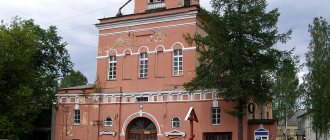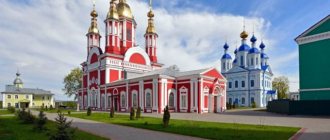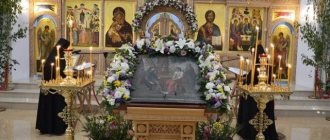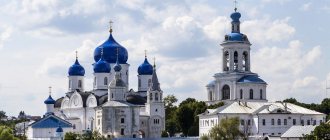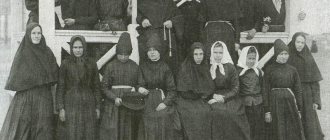History of the monastery
In the middle of the 18th century, a cemetery was created on the outskirts of Yekaterinburg. After a while, next to it, with the money of a local merchant, a church was erected, consecrated in honor of the Dormition of the Mother of God, and parables, where several women settled in 1796. The virtuous mothers created a community, each member of which prayed, fasted and worked hard every day. The number of people increased, everyone was accepted here, from little girls to old women. Therefore, the building was called an almshouse.
Alexander Nevsky Novo-Tikhvin Monastery in Yekaterinburg
- Soon the city council allocated a small monthly salary to the humble and righteous nuns. The sisters, who had been preaching the monastic way of life for a long time, showed a desire to create an entire monastic complex around the almshouse. Abbess Tatiana soon received a blessing to create a monastery from the Monk Isaiah. However, she had to overcome great difficulties before the authorities allocated money for the construction of new buildings.
- Together with her assistant, Abbess Tatiana went to St. Petersburg, where they were sheltered by retired Admiral Fyodor Ushakov, who showed a great desire to help the righteous nuns. He personally corresponded with the Archbishop of Perm, established a dialogue with the most important persons of the Synod and found people who were willing to make colossal donations for the construction of a convent in Yekaterinburg. Living in the capital, the nuns patiently waited for help and humbly prayed before the “Tikhvin” icon given to them.
- The official establishment of the Novo-Tikhvin Hermitage occurred at the very end of 1809. Soon Tatyana took monastic vows and received the name Taisiya. Before leaving for her homeland, mother received 25 fragments of miraculous relics from the St. Sophia Cathedral as a gift. After the opening of the monastery, a tradition of religious processions around the monastery was born with the “Tikhvin” image at the head. As the procession gained significance and spread to other areas, a large number of pilgrims learned about the existence of the Tikhvin desert.
On a note!
Before leaving fully for the monastery, the newly minted nun is given the opportunity to sensibly assess her own strengths and be convinced of the firmness of her decision to devote her life to daily service to God. If she succeeds in passing the tests of will, she becomes a novice after one year. Those who feel the need for a virtuous and righteous life that purifies the body and mind go to the women's monastery. Living in a monastery, nuns pray and perform obediences, participate in divine services, and also read the Holy Scriptures.
Becoming
At the beginning of the 19th century, handicraft workshops were organized here, and the sisters continued to take in orphans and disadvantaged old people. Abbess Taisiya petitioned the Synod to allocate funds for the necessary expansion of the monastery, which was becoming increasingly popular among the population.
Alexander Nevsky Cathedral of the Novo-Tikhvin Monastery
Archbishop Justin showed a colossal desire, dreaming that the Tikhvin monastery would become first-class, with large property.
- In 1822, the hermitage was officially approved; Taisiya created a charter based on the principles of the community of the Sarov Monastery. Alexander I showed concern for the newly created monastery. After the discovery, to which the emperor personally put a lot of work, he made donations in the form of precious utensils. In the fall, Alexander I visited the monastery, where he examined the architecture and talked with the nuns.
- In 1823, the Church of All Saints, which arose on the basis of a stone chapel, was solemnly consecrated. Work continued on the construction of the A. Nevsky Church, the first stone of which was laid in 1814. At the same time, sister cells, utility rooms, hotels, houses for disadvantaged laymen, as well as a perimeter fence appeared on the territory. In 1826, Abbess Taisiya left the world, living in great zeal for the Tikhvin monastery.
- The new abbess was Mother Alexandra, who served in the desert until 1858. She was a meek, modest woman with a hardworking character; she, like her predecessor, cared about the improvement of the desert and spiritual exaltation. Under Mother Alexandra, old handicraft workshops flourished and new ones were built, the monastery acquired two country houses.
- In 1832, the temple of the icon of the Mother of God “Joy of All Who Sorrow,” built next to the hospital wards, was solemnly consecrated. Now people undergoing treatment and unable to get out of bed had the opportunity to participate in worship services through open doors.
- The third abbess of the Novo-Tikhvin Hermitage was Mother Magdalene, who managed to maintain a calm and hardworking atmosphere within the walls of the convent. The number of sisters increased every year, work was carried out to decorate old churches and build new ones. In 1881, the Cathedral of Simeon of Verkhoturye was founded on Malobulzinskaya Zaimka. Abbess Magdalene served for the good of the desert for 35 years, and in 1893 her humble soul went to the Lord.
- The next abbess was a nun, also named Magdalene. Contemporaries spoke of mother’s great dedication, her hard work and spiritual simplicity. Magdalene believed that salvation came through daily prayer and reading the Holy Letter. In 1910, anniversary celebrations were held dedicated to the 100th anniversary of the Tikhvin Hermitage, which was considered very comfortable and large.
On a note!
Before the revolution of 1917, the nuns of the monastery mastered many new crafts: they painted porcelain, painted on velvet fibers, burned on leather and wood, and made artificial flowers. There were six churches on the territory, there were hospital buildings and almshouses, and new cathedrals and outbuildings were also erected on the estates. The sisters continued to provide compassionate assistance to orphans, the elderly and the disadvantaged. The laity who came here were distracted from the daily bustle and found great consolation in prayers.
Years of ruin
In 1918, the nuns provided fresh food to Emperor Nicholas II and his family, who were soon shot by the Bolsheviks. The sisters carried food even when no one was left alive. The novices continued to pray and lead a monastic life until 1922, when the authorities forcibly closed the gates of the monastery. At the same time, the Bolsheviks burned documentation, ancient books and chronicles stored in desert libraries.
Historical photo of the Novo-Tikhvin Monastery
Most of the sisters were sent to exile and prison. Others remained in Yekaterinburg or its environs, where they lived in apartments of several people. Abbess Magdalene organized a small community that continued to live according to Orthodox canons. Many such groups helped ordinary lay people maintain their faith.
St. Tikhvin Convent in the village of Kurilovo Diocesan monasteries of the Russian Orthodox Church
The second abbess, nun Evstolia, reconstructed the Tikhvin Church, erected by Teplov in the 1830s, and expanded the economy to include livestock farming. Abbess Raphaila laid the foundation for the new Holy Cross Cathedral, consecrated in 1895, and built three stone buildings and a courtyard in Saransk. Raphael's mother died in 1897, she was inherited by Abbess Seraphima, who built a three-tier bell tower, two stone buildings, many utility buildings, and installed a water supply system in the monastery. The uniqueness of the monastery's layout was that the rest of the area was free of utilitarian buildings - there were two churches, the view of which from the village was not blocked by any buildings except a low stone decorative wall and an arched gate framed by turrets.
The first church in the monastery was founded by the Teplovs in the year of the death of St. Seraphim, 1833. In 1835 the temple was consecrated. Judging by the surviving images, the temple was designed to be cross-domed, in the traditions of late provincial classicism. In 1851, 1857 and 1858 the temple was expanded with chapels consecrated in the name of the Smolensk Icon of the Mother of God and in honor of the Ethereal Powers of Heaven. The second temple, in the name of the Exaltation of the Life-Giving Cross of the Lord (Krestovozdvizhensky), was built in 1890 at the monastery’s own expense.
In addition to the highly revered personal belongings of St. Seraphim and the miraculous Tikhvin Icon of the Mother of God, donors donated many relics to the monastery: a copy of the Tikhvin Icon, an image of the Sign of the Mother of God, copied from the famous icon of the Ponetaevsky Monastery, a silver cross with particles of the relics of the Apostle Andrew the First-Called, an ark with particles of the relics of several martyrs. This ark was opened during worship. There was another cross in the cathedral with the relics of Saints John Chrysostom, Basil the Great, Gregory the Theologian and Nicholas the Pleasant. Particles of the robe of the Mother of God were embedded in one of the icons, Saints Panteleimon and Harlampius. Of all the revered images, believers preserved only the Tikhvin Icon, which returned to the revived monastery in 1996. Pre-revolutionary reference books devoted a lot of space to the Kurilov Monastery precisely because it had especially revered shrines and was distinguished by its splendid and solemn worship. There was an extensive hotel that has survived to this day. Especially many lay people came to the monastery for the temple holiday on July 25-26, the day of the appearance of the Tikhvin Icon of the Mother of God, when a crowded procession of the cross left the walls of the monastery and went around the village. An influx of pilgrims was also observed on September 14 and November 8. The number of tonsured nuns has never been large: in 1895, the staff of the Kurilovsky Monastery consisted of an abbess, one schema-monastery and 30 nuns. There were 133 novices, and before 1910, 260 nuns were already laboring in the monastery, although the number of nuns among them again did not exceed 45 people. Over time, the monastery developed into a fairly effective economic structure: according to data from the end of the 19th century, the nuns. there were 306 des. lands, a large garden, a livestock farm, several wooden houses for the clergy, a mill, fish lakes, barracks for seasonal workers, many outbuildings with workshops, including kirichny ones.
In 1918, 418 acres of land and 22 buildings were immediately confiscated from the nuns and given to the local population. There were still 40 buildings under the jurisdiction of the monastery. Soon the authorities confiscated the abbot's building, which was given over to a school, and a large building of a hospice house for a granary. The nuns did not have to use the remaining 38 buildings for long: they were not allowed to switch to the charter of the agricultural association, but were registered only as a parish. In 1922, the community managed to reorganize into an agricultural partnership.
In 1924, the last nuns of the Chufarovsky Holy Trinity Monastery were transferred to Kurilovo, and in 1926 the complete destruction of the monastery followed. During the years of Soviet power, both stone churches, the bell tower, and all service buildings were destroyed. The monastery housed an orphanage and a state farm.
In 1995, the first nuns appeared - two nuns and a novice. In 1997 there were already more than 20 nuns, including two schema nuns. From the village Sabanov, a wooden church was transported, rebuilt again and on November 2, 1997, consecrated by Bishop Barsanuphius of Saransk and Mordovia (now Metropolitan of St. Petersburg and Ladoga, manager of the affairs of the Moscow Patriarchate) in honor of the Tikhvin Icon of the Mother of God.
